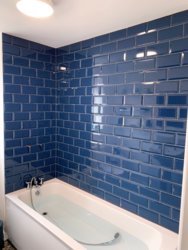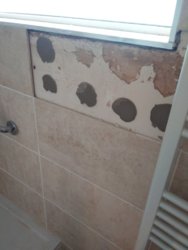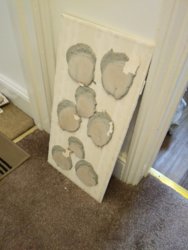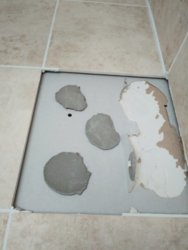Install the app
how_to_install_app_on_ios
follow_along_with_video_below_to_see_how_to_install_our_site_as_web_app

Note: this_feature_currently_may_not_be_available_in_some_browsers
You are using an out of date browser. It may not display this or other websites correctly.
You should upgrade or use an alternative browser.
You should upgrade or use an alternative browser.
- Thread starter Matty A
- Start date
- Replies 452
- Views 282K
-
- Tags
- advice association british tiling usa
Currently reading:
Tiling Standards
Discuss Tiling Standards in the Tilers' Talk - All Other Countries area at TilersForums.com.
Soso
TF
Leader
TF
Hi all, it’s been a while but the dispute is still ongoing. They are now saying that they had to start with a full tile at the bath due to metro tile choice, is this correct? See their reply
We are of the belief that based on the tile selection being bevelled edged, that starting with a cut above the bath, would lead to a greater risk of water ingress as well as less aesthetically pleasing due to the silicone line not being consistent.
We are of the belief that based on the tile selection being bevelled edged, that starting with a cut above the bath, would lead to a greater risk of water ingress as well as less aesthetically pleasing due to the silicone line not being consistent.
H
hmtiling
NonsenseHi all, it’s been a while but the dispute is still ongoing. They are now saying that they had to start with a full tile at the bath due to metro tile choice, is this correct? See their reply
We are of the belief that based on the tile selection being bevelled edged, that starting with a cut above the bath, would lead to a greater risk of water ingress as well as less aesthetically pleasing due to the silicone line not being consistent.
T
Time's Ran Out
Ask the client how to set the room out!
That’s why they are paying you - to do a professional job.
Clients away on holiday, that’s okay I’ll send him a photo of how it’s going to look - he’s going to be really confident in your ability.
What’s been done is sh*te and these chancers do our trade no favours.
Must have been on song that night - apologies!
[automerge]1562962315[/automerge]Nonsense
Thought so
Regarding the vertical corner joints, they say.
Wickes Way of Working stipulates that grout is to be applied to all vertical joints as well as joints between wall and floor tiles etc.
Do you also know what size these corner joints should be as some areas are as small as 1 - 2mm?
H
hmtiling
They're wrong(lying) again. All transitions between walls and floors should be siliconed as per adhesive manufacturer instructions. Find out what adhesive and grout they used and you could get that in writing from them[automerge]1562962315[/automerge]
Thought so View attachment 108050
Regarding the vertical corner joints, they say.
Wickes Way of Working stipulates that grout is to be applied to all vertical joints as well as joints between wall and floor tiles etc.
Do you also know what size these corner joints should be as some areas are as small as 1 - 2mm?
J
Just Rizzle
you have a ceiling thats on the wonk re board ceiling and skim the tiling looks fine except the slither cut.
alternatively knock the whole house down and get them to get the joists level.
ps on my 6th can of Guinness may not be thinking straight but i feel great.
but im leveller than that ceiling lol
alternatively knock the whole house down and get them to get the joists level.
ps on my 6th can of Guinness may not be thinking straight but i feel great.
but im leveller than that ceiling lol
U
Unused Account 1
I just did one 200x75,but vertically,did same procedure battened up then tiled,they were a bit sizy,looked ok but once finished running out when put shower screen ,all youcan do is go with the wall ,Tell me about it! I have a complete bathroom in metros next month
Myrdaal
TF
No update as to what happened. so i'll throw in...Its almost definitely not British Standard. I work at the building site end of things, and Site managers love to show off their 'knowledge' of BS/NHBC standards. Cutting into the bath has NEVER been an issue. Having said that, they look like the 'metro' type tiles there, and cutting in wouldn't have looked good. That rip looks to be about 10mm at the widest, as Andystiletiling said, your tiler should have changed spacers to absorb it, it would be unnoticeable. Bit late now, but its my opinion dark grouts and white glazed tiles is never a good idea, it just highlights any imperfections, (and those small tiles are always a bit 'sizey') the bevel in the tiles would make it look just as good with white grout. 
Thanks all for your help and the information you have provided me. Received the 1st positive email yesterday from them saying “you have clearly done your research”, offering a refund for the tiling or for the work to be redone.
I notice that most of you hate installing metro tiles, why are they so bad? They responded.....”The specific tiles you have chosen are notoriously problematic and whilst we are happy to reinstall replacements if this is what you decide, we would suggest an alternative tile is chosen to ensure the finish is completed in line with the standards you have quoted and to enable us to complete your bathroom to meet both yours and our expectations”
But I like metro tiles?! Would you advise against also? Not sure I trust them to redo the work, so thinking of getting a quote from a TTA approved tiler (Swansea area), if you know anyone willing to take on my work?
I notice that most of you hate installing metro tiles, why are they so bad? They responded.....”The specific tiles you have chosen are notoriously problematic and whilst we are happy to reinstall replacements if this is what you decide, we would suggest an alternative tile is chosen to ensure the finish is completed in line with the standards you have quoted and to enable us to complete your bathroom to meet both yours and our expectations”
But I like metro tiles?! Would you advise against also? Not sure I trust them to redo the work, so thinking of getting a quote from a TTA approved tiler (Swansea area), if you know anyone willing to take on my work?
D
Dumbo
I don't like metros but that is a personal thing many tilers and I mean proper tilers , check their references are capable of producing quality work with metros,.
If you want a tta tiler log on to the tta website I'm sure you will find someone in your area .
Tiles.org.uk
If you want a tta tiler log on to the tta website I'm sure you will find someone in your area .
Tiles.org.uk
Last edited by a moderator:
Any tiler worth there salt should be able to use metros and produce a high standard.
The reason tilers don't like them is because there time consuming, being a small tile, going around and inside windows take forever, and there difficult to grout because of the bevelle.
Personally, I don't mind them, as I tile alot of kitchens, and can't remember the last time I did one that wasn't metros...
The reason tilers don't like them is because there time consuming, being a small tile, going around and inside windows take forever, and there difficult to grout because of the bevelle.
Personally, I don't mind them, as I tile alot of kitchens, and can't remember the last time I did one that wasn't metros...
D
Dumbo
Just be aware that nobody comes around from the tta to check the quality of Your work before accepting your membership , also things like checkatrade rely on reviews from customers who maybe can't tell the difference between a good and bad job .
Do your own research ,
Do your own research ,
O
On one
Nothing too problematic at all with Metro tiles......just certain setting out criteria to be aware of, which a capable tiler would be aware of.
I would be asking close personal friends for recommendations, not necessarily just via asking on social media sites.
I would be asking close personal friends for recommendations, not necessarily just via asking on social media sites.
Tiler Durden
TF
Another reason why metros or any smaller tile is a bad choice within a shower..... the grout joints! Far more grout to discolour. An Epoxy grout is one solution, also a grout sealer but they still do discolour. This is why large format tiles have become popular, also XL format has started to come through.
I think if they're brick fashion you have the old middle of the tile being thicker than the end so against a tile trim it looks terrible unless youve set it out to finish all external corners on 1/4 and 3/4 of the tile. So very limited setting out options width wise.
Thats a pain.
Thats a pain.
Metros look smart, but they are usually cheap , bent and sizey , I’ve just done 60m2 of them, bit bigger, 30x10cm, Johnson’s very own wicks shi it , bent , curled in at corners and sizey , they can run off a mountain side for all I care 
What grout did you use ??....Metros look smart, but they are usually cheap , bent and sizey , I’ve just done 60m2 of them, bit bigger, 30x10cm, Johnson’s very own wicks shi it , bent , curled in at corners and sizey , they can run off a mountain side for all I care
It’s going to be anthracite epoxybio , hopefully though @Andystiletiling is doing it,as I’m going on holiday todayWhat grout did you use ??....
But it’s pretty good stuff to use, but it defo needs to set faster
qualitywork
TF
Setting out is all to ****. Most good tilers would plan it so no small slithers are evident. Occasionally this cannot be avoided if you have large areas with lots of undulating levels to take into account. However, i haven't had a job in the last 2 decades where i had small slithers like this. Personally i would have gone 30% cuts on the bath and this would have resulted in an acceptable, but not perfect solution. I get many baths that are not straight anyway, and have to cut the row above bath to suit.
BTW, i used to tile for fitters from wickes and always the standard is awful. Also no decent tiler would work for the rates that wickes allow for. When i was doing kitchens, they allowed £25-£30 per metre on 4 metre splashes!
How can we as tilers do a quality job on those rates? Unless of course i am ridiculously slow.....
(A big hi to all the tilers on this forum!)
Best wishes
James
BTW, i used to tile for fitters from wickes and always the standard is awful. Also no decent tiler would work for the rates that wickes allow for. When i was doing kitchens, they allowed £25-£30 per metre on 4 metre splashes!
How can we as tilers do a quality job on those rates? Unless of course i am ridiculously slow.....
(A big hi to all the tilers on this forum!)
Best wishes
James
Glad you got a good result.
I did this one the other day. Set out with 2mm spacers (my 1st choice for metros) but would have ended up with raking slithers disappearing to nothing at the ceiling - exactly like what you've been left with.
Lost 16mm at the top by swapping to a 3mm spacer.
It's not rocket science. Nice to see a customer taking no crap!

I did this one the other day. Set out with 2mm spacers (my 1st choice for metros) but would have ended up with raking slithers disappearing to nothing at the ceiling - exactly like what you've been left with.
Lost 16mm at the top by swapping to a 3mm spacer.
It's not rocket science. Nice to see a customer taking no crap!

Looks great! Unfortunately they are now playing silly buggers for the amount they will refund. Just out of interest, how much would you charge for removal of 6sqm of tiles and installing new ones?Glad you got a good result.
I did this one the other day. Set out with 2mm spacers (my 1st choice for metros) but would have ended up with raking slithers disappearing to nothing at the ceiling - exactly like what you've been left with.
Lost 16mm at the top by swapping to a 3mm spacer.
It's not rocket science. Nice to see a customer taking no crap!
View attachment 109078
Sorry about discussing prices on open forum. Doesn’t seem to be any members in my local area and how do you pm a member? Do you click on their profile and click “start a conversation”? There is a conversation on the open forum about prices, would it be ok to do it there or is it a no noPrices are not discussed in open forum, but if you Pm a member from your local area they may be able to help.
Tiling Standards - British Tiling Standards Download and Information
British Standard in Wall and Floor Tiling
Register at TilersForums.com for free to obtain the British Standards in Wall and Floor Tiling BS 5385. That's both:-
If you require help with your wall or floor tiling then the British Standards in Wall and Floor Tiling BS 5385 (its BS name and number) can help, whether it's a tiling contractor who you think has carried out inferior tiling work, or whether it's a national tile outlet, or even a local tile shop that's supplied tiles you think are not up to the British standard, then please register to the forum for free and post a new support thread of your own. Tell us as much about the situation as possible. Include as many pictures as you can. Let us know what stage the job is at. And we will do all we can to help you.
We have helped thousands of homeowners and contractors in similar situations and would be more than happy to help rectify the tiling work.

 www.tilersforums.com
www.tilersforums.com
Some search terms related to British tiling standards:-
British Standard in Wall and Floor Tiling
British Standards in Wall and Floor Tiling BS 5385
Register at TilersForums.com for free to obtain the British Standards in Wall and Floor Tiling BS 5385. That's both:-
- British Standards 5385-1: 2018
- BS 5385-2:2015
- BS 5385-1: design and installation of ceramic, natural stone, and mosaic wall tiling in normal internal conditions.
- BS 5385-5: design and installation of terrazzo, natural stone, and agglomerated stone tile and slab flooring.
If you require help with your wall or floor tiling then the British Standards in Wall and Floor Tiling BS 5385 (its BS name and number) can help, whether it's a tiling contractor who you think has carried out inferior tiling work, or whether it's a national tile outlet, or even a local tile shop that's supplied tiles you think are not up to the British standard, then please register to the forum for free and post a new support thread of your own. Tell us as much about the situation as possible. Include as many pictures as you can. Let us know what stage the job is at. And we will do all we can to help you.
We have helped thousands of homeowners and contractors in similar situations and would be more than happy to help rectify the tiling work.
Uk Libraries With Access To British Standards In Tiling
Libraries in the UK with BSOL UK Libraries with access to British Tiling Standards BS 5385 Company City Post code Kent Libraries and Archives Maidstone ME14 2LH MLA - Bolton Public Libraries Bolton BL1 1SA MLA - Essex Libraries Chelmsford CM1 1LH MLA - Hull Libraries Hull HU1 3TF MLA...
Some search terms related to British tiling standards:-
- Wall Tiling Standards
- Floor Tiling Standard
- Kitchen Tiling Standard
- Bathroom Tiling Standard
Last edited:
I think you're being over critical, you chose the worst grout possible for those tiles, and it's shown up in the ceiling. I've seen worse.
Are there other walls done, around a window maybe, to see what cut would have bee left on the head/sill?
That sliver (I wouldn't even call it that, I've done smaller cuts) wouldn't have looked so bad if the ceiling was level.
Simple solution, take light fitting down, over board, skim, paint, refit light. Kill 2 birds with one stone, small cut disappears and you won't notice the cocked up ceiling.
Are there other walls done, around a window maybe, to see what cut would have bee left on the head/sill?
That sliver (I wouldn't even call it that, I've done smaller cuts) wouldn't have looked so bad if the ceiling was level.
Simple solution, take light fitting down, over board, skim, paint, refit light. Kill 2 birds with one stone, small cut disappears and you won't notice the cocked up ceiling.
Last edited:
i dont think its a must to start with full tile if you have done your calculation as an installer they should have raised the first tile to a certain height so that they will cut small out of the last tile on top the cutting one will not be visible then the off cut will finally transfer to the base to avoid this kind of situation.
[automerge]1571143463[/automerge]
if your wall is not plum you can centralize your work by mark out the center of your wall make it your start point so that you can transfer your off cut to the corner of the wall,
if you wall is not flat why not ask the client to pay for re-plastering or re- rendering of the wall.
[automerge]1571143463[/automerge]
if your wall is not plum you can centralize your work by mark out the center of your wall make it your start point so that you can transfer your off cut to the corner of the wall,
if you wall is not flat why not ask the client to pay for re-plastering or re- rendering of the wall.
Last edited:
Joy2019
-
Any good tiler would check the bath for level before even fixing a full tile off it in the first place! Make a gauge rod with tiles and joint (cant go wrong) mark a datum then using gauge rod to see if acceptable cut to ceiling at all points if not centre the wall vertically or centre centre tile to give best cuts. obviously too late now as tiler has tiled the room. Best easiest option is to maybe add another skin or 2 of plaster board to ceiling to eliminate the small cuts, or coving as someone suggested although not a conventional finish in a bathroom.
Soso
TF
600 rectified tiles? Most definitely needs a tile leveling system for a superior finish. The reason he used 7mm grout lines was an attempt to limit lipage. 2mm grout lines (max3) with zero lipage should have been the goal
IMPORTANT CHANGES TO BS 5385-1 WALL AND FLOOR TILING
POSTED BY PHILIP JENKINS of BAL ON 20TH JULY 2018
As part of the five-year review of British Standards and reflecting changes within the tiling industry since 2009 – BS 5385 Part 1: 2018 has now been published. One significant change made was to exclude the use of plywood as a background material for the direct fixing of ceramic wall and natural stone tiles.Clause 6.1.2.7 Other sheets and boards (see also 6.2.3.3) now states:
“The use of sheets or boards that are subject to movement from changes in moisture content should be avoided. Plywood and other wood-based sheets or boards should not be used for direct tiling”.
A significant uplift in the use of tile backer boards – such as BAL Board – and a wide variation in quality of plywood available on the market has provided a solid case for the removal of plywood from the standards.
David Wilson, UK Head of Technical Services at BAL and member of the TTA Technical Committee said: “Previously it was recognised in BS5385 Part 1: 2009 that tiling direct to plywood was possible, providing this was restricted to small areas and be “installed in such a way that they provide a [dimensional] stable and rigid background” the quality of plywood for tiling purposes has decreased significantly with cheaper imports flooding the market.
“While higher quality external grade plywood is still available – it is significantly more expensive.
“It is important to consider though that that wood is a hygroscopic material which means that its moisture content will change dependent upon any changes in the environmental conditions on site. Therefore, dimensional stability of wood-based boards cannot be assured there is always a risk to installing ceramic or natural stone tiles onto plywood or other wood-based sheets,
Another technical consideration for wall tiling is weight restrictions. Just as a side note at this point, if you don't have a clue what any of this is, then consider a tiling course, and research it well before paying any money. Plywood is deemed to have a maximum weight of tiling per m² of 30 kg compared to proprietary tile backing boards which generally are capable of supporting heavier weights per m² of tiling (As per table 3 of BS 5385-1: 2018).
“A competitive tile backing board market means that prices are more attractive to tile fixers and contractors. This combined with the additional features and benefits of providing background for tiling which are dimensional stable and resistant to moisture and thermal movement. “
However, while plywood is not recommended as a background for direct wall tiling, it can still be used as a structural board when overlaid with a suitable tile backing board, particularly where installation of mechanical fixings is required e.g. for mesh backed natural stone where it is not possible to remove 75% or of the mesh backing.
Other changes to BS standards.
Previously in internal dry wall areas it was recommended that tile adhesive should cover a minimum of 50% coverage spread evenly over the back of the tile. However, driven by necessity, with the increase in the size and types of tiles i.e. larger formats and thin ceramic panels, now available of the market, BS 5385-1: 2018 advises: “Tiles with a surface area of less than 0.1 m², but which weigh more per square meter than 70% of the background’s capacity to carry the weight, should be solidly bedded e.g. the maximum weight of tile that can be supported by Gypsum plaster = 20 kg; whereas 9 mm thick porcelain tiles, which weigh approximately 18 kg/m², weigh more than 70% of 20 kg (14 kg) therefore, they should be solidly bedded regardless of their size”
Included within the scope of BS 5385-1: 2018 are large format ceramic tiles, ceramic panels i.e. tiles with a surface area >1m² (any edge length >1200 mm) and thin tiles
i.e. ceramic tiles and panels with a panel thickness of ≤ 5.5 mm. To reflect this, additional changes have also been made in the minimum recommended grout joint width, dependent on the tile/panel size, e.g. the minimum grout widths vary by tile facial area – an example as follows:
- For tiles with a facial area of less than 0.1m² with no side > 600mm long, a minimum joint width of 2mm is required.
- Tiles with a facial area 0.1m² to 1m² with no side>1200mm long, a minimum joint width of 3 mm is required.
- Joints between ceramic panels should be increased pro-rata to panel size (e.g. for a 3m long ceramic panels the minimum required joint width between these panels is 5mm.
- Natural Stone Slabs i.e. stone which is more than 12mm thick,
- Agglomerate stone,
- Metal, plastic resin, mirror or glass tiles of a similar construction
Don't mind me while I bump up some older but good threads. If you can contribute to the thread, go ahead. But if it's nothing for you then don't reply and it'll soon drop off the What's New page etc.
Worth linking to our new forum structure while I'm doing stuff:-
Worth linking to our new forum structure while I'm doing stuff:-
This thread hasn't been replied to for 14 days, so replying to this one may not get a response. Post a new thread instead.
Reply to Tiling Standards in the Tilers' Talk - All Other Countries area at TilersForums.com
There are similar tiling threads here
- drowninginit
- UK Tiling Forum
- 6
- 610
- Replies
- 6
- Views
- 610
- Emma123
- America Tile Forum
- 1
- 2K
- Replies
- 1
- Views
- 2K
- apfeltaschen
- America Tile Forum
- 5
- 6K
- Replies
- 5
- Views
- 6K
- Replies
- 9
- Views
- 5K



